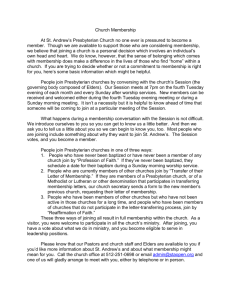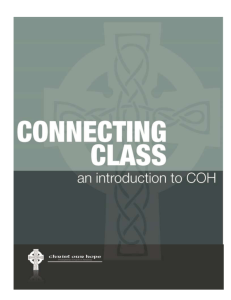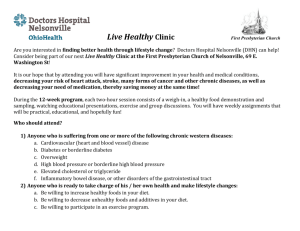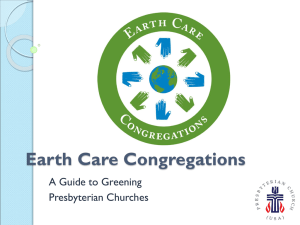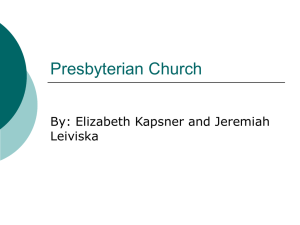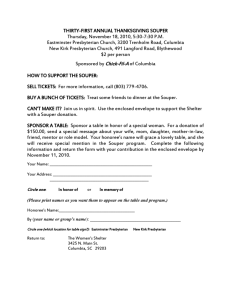A Brief History of the Presbyterian Church in America (PCA)
advertisement
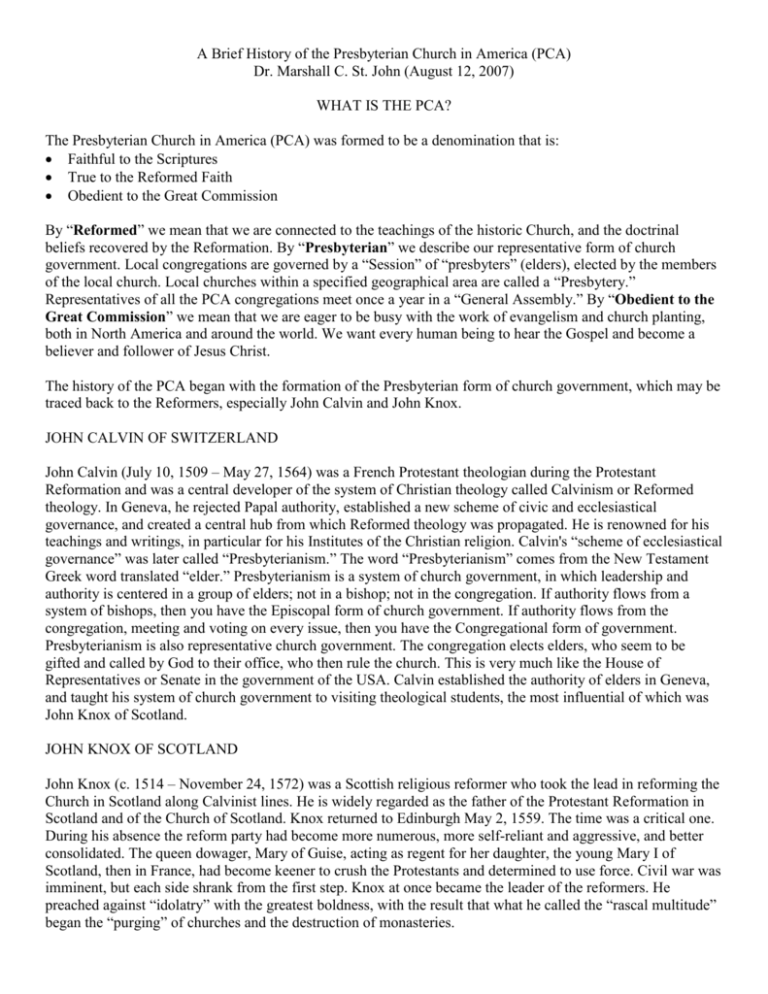
A Brief History of the Presbyterian Church in America (PCA) Dr. Marshall C. St. John (August 12, 2007) WHAT IS THE PCA? The Presbyterian Church in America (PCA) was formed to be a denomination that is: Faithful to the Scriptures True to the Reformed Faith Obedient to the Great Commission By “Reformed” we mean that we are connected to the teachings of the historic Church, and the doctrinal beliefs recovered by the Reformation. By “Presbyterian” we describe our representative form of church government. Local congregations are governed by a “Session” of “presbyters” (elders), elected by the members of the local church. Local churches within a specified geographical area are called a “Presbytery.” Representatives of all the PCA congregations meet once a year in a “General Assembly.” By “Obedient to the Great Commission” we mean that we are eager to be busy with the work of evangelism and church planting, both in North America and around the world. We want every human being to hear the Gospel and become a believer and follower of Jesus Christ. The history of the PCA began with the formation of the Presbyterian form of church government, which may be traced back to the Reformers, especially John Calvin and John Knox. JOHN CALVIN OF SWITZERLAND John Calvin (July 10, 1509 – May 27, 1564) was a French Protestant theologian during the Protestant Reformation and was a central developer of the system of Christian theology called Calvinism or Reformed theology. In Geneva, he rejected Papal authority, established a new scheme of civic and ecclesiastical governance, and created a central hub from which Reformed theology was propagated. He is renowned for his teachings and writings, in particular for his Institutes of the Christian religion. Calvin's “scheme of ecclesiastical governance” was later called “Presbyterianism.” The word “Presbyterianism” comes from the New Testament Greek word translated “elder.” Presbyterianism is a system of church government, in which leadership and authority is centered in a group of elders; not in a bishop; not in the congregation. If authority flows from a system of bishops, then you have the Episcopal form of church government. If authority flows from the congregation, meeting and voting on every issue, then you have the Congregational form of government. Presbyterianism is also representative church government. The congregation elects elders, who seem to be gifted and called by God to their office, who then rule the church. This is very much like the House of Representatives or Senate in the government of the USA. Calvin established the authority of elders in Geneva, and taught his system of church government to visiting theological students, the most influential of which was John Knox of Scotland. JOHN KNOX OF SCOTLAND John Knox (c. 1514 – November 24, 1572) was a Scottish religious reformer who took the lead in reforming the Church in Scotland along Calvinist lines. He is widely regarded as the father of the Protestant Reformation in Scotland and of the Church of Scotland. Knox returned to Edinburgh May 2, 1559. The time was a critical one. During his absence the reform party had become more numerous, more self-reliant and aggressive, and better consolidated. The queen dowager, Mary of Guise, acting as regent for her daughter, the young Mary I of Scotland, then in France, had become keener to crush the Protestants and determined to use force. Civil war was imminent, but each side shrank from the first step. Knox at once became the leader of the reformers. He preached against “idolatry” with the greatest boldness, with the result that what he called the “rascal multitude” began the “purging” of churches and the destruction of monasteries. Politics and religion were closely intertwined; the reformers did not hesitate to seek the help of England. Knox negotiated with the English government to secure its support, and he approved of the declaration by the lords of his party in October 1559 suspending their allegiance to the regent. The death of the latter in June 1560 opened the way to a cessation of hostilities and an agreement to leave the settlement of ecclesiastical questions to the Scottish estates. The doctrine, worship, and government of the Roman Church were overthrown by the parliament of 1560 and Protestantism established as the national religion. Knox, assisted by five other ministers, formulated the confession of faith adopted at this time and drew up the constitution of the new Church: the First Book of Discipline. The Church—or Kirk—was organized on something approaching Presbyterian lines. Priests were replaced by ministers (from the Latin for servants), with each parish governed by the Kirk Session of elders. John Knox died in Edinburgh on November 24, 1572. IRISH PRESBYTERIANISM From Scotland, Presbyterianism spread to Ireland. Presbyterianism in Ireland dates from the time of the Plantation of Ulster in 1610. During the reign of James I of Ireland (James VI of Scotland) a large number of Scottish Presbyterians emigrated to Ireland. The first move away from the Church of Scotland, of which the Presbyterians in Ireland were part, saw the creation of the Presbytery of Ulster in 1642 by chaplains of a Scottish army which had arrived to crush the rising of 1641. Under Cromwell congregations multiplied and new presbyteries were formed. After the Restoration, nonconforming ministers were removed from parishes of the Established Church, but the Irish administration could not afford to alienate such a substantial Protestant population and Presbyterianism was allowed to continue in the country. AMERICAN PRESBYTERIANISM The Rev. Francis Makemie (1658-1708) was an Irishman, born near Rathmelton, Donegal county, Ireland in 1658. He studied for the ministry at Glasgow University, where in February, 1676, he was a student in the third class. In 1680 the Irish Presbytery of Laggan received a letter from Judge William Stevens, a member of Lord Baltimore's Council, entreating that ministers be sent to Maryland and Virginia. The next year it licensed Mr. Makemie, and ordained him soon in 1682, as a missionary for the American colonies. He preached for a time in Barbados. About 1684 he began his labors on the continent. In 1690 his name figures in the records of Accomac County, Virginia, where he was engaged in the West India trade, and where in 1692 four hundred and fifty acres of land were granted to him. Here he married Naomi, daughter of William Anderson, a wealthy merchant. In the Southeast corner of Maryland there were three or four “meeting houses,” and in the one at Snow Hill he organized a church. An elder and merchant, Adam Spence, had probably signed the Solemn League and Covenant in Scotland, and a descendant of his, reciting the tradition of a hundred and thirty years, thus writes of Mr. Makemie: “One generation has uttered his praises in the ears of its successor, and you may, even yet, hear their echo. Parents made his surname the Christian name of their children, until, in the neighborhood of Snow Hill, it has become a common one.” This hill was his base of missionary operations. It was not long before quite a number of congregations were gathered in the region which he had selected as his field of labor. An itinerant missionary, and in reality the bishop of a primitive diocese, he journeyed from place to place, sometimes on the eastern shore of Maryland, sometimes in Virginia, and sometimes extending his journeys as far as South Carolina. To the extent of his ability he supplied the feeble churches, but he deeply felt the need of others to assist him. In 1704 he went to London, and on his return brought back two other missionaries, who, along with Makemie himself and four others, formed at Philadelphia in the spring of 1706 the first Presbytery. Mr. Makemie died at his residence in Accomac, Virginia, in the Summer of 1708, leaving a widow and two daughters. He made liberal bequests to charitable objects, and distributed his valuable library among his family and two or three other friends. He is generally regarded as the first regular and thorough Presbyterian in America, and the father of the American Presbyterian Church. THE WAR BETWEEN THE STATES A great deal happened in the history of the Presbyterian Church in the United States between the time of Francis Makemie and the War Between the States. Presbyterians existed in half-a-dozen different denominations. But the largest was the Presbyterian Church in the U.S.A. This denomination became two separate denominations on December 4, 1861, when commissioners from Southern presbyteries met in Augusta, Georgia, to renounce the jurisdiction of the Presbyterian Church in the U.S.A. (Old School) and to form the Presbyterian Church in the Confederate States of America. (After the war, the church changed its name to the Presbyterian Church in the United States.) In its “Address to All the Churches of Jesus Christ throughout the Earth,” the church outlined the Northern ecclesiastical indiscretions that forced its separation, especially the Gardiner Springs Resolutions of the previous General Assembly that declared the church's obligation to uphold the Union and support the federal constitution. In the minds of Southern Presbyterians, this was a violation of the spirituality of the church by an unwarranted engagement in partisan politics. Thus we find the PCUS, the mother church of the PCA, coming into existence. Let us now move ahead very rapidly over one hundred years, during which the PCUS (and most American denominations of all persuasions) declined from its spiritual peak into Liberalism. WHY WAS THE PCA CREATED? The PCUS (Presbyterian Church in the US) is the mother church of the PCA. When the PCA was brought into existence in 1973 it was created by churches and elders separating themselves from the PCUS in order to found a Bible-based truly Christian Church. There are a number of reasons that these churches and elders left the PCUS: 1. The PCUS denied the authority of the Bible. 2. The PCUS required the ordination of women as elders and deacons. 3. The PCUS defended abortion and funded abortions. 4. The PCUS joined the National and World Council of Churches which support communism around the world. 5. The PCUS defended Darwinian evolution. 6. The PCUS was promoting sexual immorality to church youth. 7. The PCUS opposed capital punishment of murderers. 8. The PCUS welcomed some ministers who denied the virgin birth, and the deity and resurrection of Jesus, and refused to accept some ministers who believed in these doctrines. 9. The PCUS was run by a political machine which excluded conservatives from influential posts. 10. The PCUS redefined missions as social action, and downplayed evangelism and church planting. HOW WAS THE PCA CREATED? Conservatives in the PCUS had fought the growing “Liberalism” in their denomination for decades. It became clear that a conspiracy of liberal ministers and seminary professors in the Presbyterian Church in the United States—the so-called southern Church—were engaged in an organized effort to gain control of the church. These men led by Dr. Ernest Trice Thompson—a professor at Richmond Theological Seminary—formed a secret organization which they called “The Fellowship of St. James”. They sought to have the church abandon its belief in the integrity and authority of the Bible, to water down the Westminster Confession of Faith, and to participate more actively in the National Council of Churches and the World Council of Churches. Their primary goal, however, was to unite the PCUS with the far more liberal and three times larger Presbyterian Church in the United States of America—the Northern Church. They developed a political machine to control the actions of the church. SOUTHERN PRESBYTERIAN JOURNAL To let the members of the Presbyterian Church U.S. know about this attempt to undermine our historic faith and to encourage conservatives to resist the efforts of the liberals to gain complete control, Dr. Bell (recently returned from China, the father of Billy Graham's wife, Ruth; and Dr. Henry B. Dendy, minister of the Weaverville, North Carolina Presbyterian Church, founded The Southern Presbyterian Journal. Dr. Bell served as editor and Dr. Dendy as business manager. By 1964 the secret “Fellowship of St. James” was no longer secret so they replaced it with a new and larger group which they called “The Fellowship of Concern.” They redoubled their efforts to merge our Southern Church with the far more liberal Northern Church. This group was in complete control of Assembly's Nominating Committee, many of the synods and presbyteries, the board and agencies, colleges and seminaries and most of the important committees of the church. Dr. Bell and a number of other conservative leaders met in Atlanta and concluded that informing church members regarding the direction the liberals were taking the church through the Presbyterian Journal would never return control to Bible-believing Presbyterians. They decided that an organization was needed to actively combat what the liberals were doing and that it would be a lay organization because if conservative ministers in liberal presbyteries became involved they could be defrocked. CONCERNED PRESBYTERIANS At the Journal board meeting in August of that year, Kenneth S. Keyes was asked to form and head such an organization. With $15,000 seed money which the board provided, Concerned Presbyterians was formed in the fall of 1964 with Col. Roy LeCraw of Atlanta serving as vice president, W.J. (Jack) Williamson of Greenville, Alabama, as secretary and J. M. Vroon of Miami as treasurer. The first bulletin from Concerned Presbyterians listed these reasons for concern: Because the primary mission of the church—winning people to Jesus Christ and nurturing them in the faith—is being compromised today by overemphasis on social, economic and political matters, forgetting the basic necessity for regeneration. Because the integrity and authority of the Word of God are being questioned by dubious theories of revelation in some of the literature of the church. Because some presbyteries no longer require complete loyalty to the Westminster Confession of Faith and Catechisms. Because continued membership in the National Council of Churches involves us in activities, pronouncements and programs of which we strongly disapprove and repeated protests to that body have been ignored. Because the plan to establish a central treasurer now approved by the General Assembly indicates a determination to regiment the benevolence giving of the church's members by “equalizing” their gifts-in effect actually thwarting the wishes of many donors. Because another determined effort has been started to affect a union of the Presbyterian Church U.S. with the United Presbyterian Church U.S.A—which is now engaged in negotiations to unite with denominations that do not adhere to the Reformed faith. By this time many conservative members were leaving churches which were pastored by liberal ministers. PRESBYTERIAN EVANGELISTIC FELLOWSHIP When it became evident that those in control of the PCUS were no longer interested in evangelism, Rev. William P. Hill organized the Presbyterian Evangelistic Fellowship. Starting with two full-time evangelists they eventually had fifteen evangelists serving the church. Later on this group became a sending agency for missionaries so that PCUS conservative churches which had stopped giving to the church's Board of World Missions had missionaries whom they could support. PRESBYTERIAN CHURCHMEN UNITED In 1969 more than 500 conservative ministers formed Presbyterian Churchmen United and ran 3/4 page statements of their beliefs in 29 or 30 leading newspapers. Dr. John E. Richards, pastor of the First Presbyterian Church in Macon, Georgia, headed this organization and Rev. Paul P. Settle was its field director. They both played a very active role in speaking at conservative rallies, informing members in the pews regarding what the Liberals were doing to the church. By this time presbyteries where the Liberals were in control were receiving ministers who did not believe in the Virgin Birth, the validity of Christ's sacrificial death on the cross, His bodily resurrection and other cardinal doctrines of the faith. The Board of World Missions was replacing conservative leading missionaries with men and women who no longer believed that leading the unsaved to Christ was their primary mission. The Liberally controlled courts of the church made no effort to discipline a West Virginia minister who “married” two homosexuals at a church in Washington D. C., and a Louisville, Kentucky, minister who offered himself for a position as elector in the Communist Party. Some of the Liberal presbyteries were blocking the efforts of conservative churches to call conservative ministers. A NEW SEMINARY WAS NEEDED Southern Presbyterian conservatives, like their counterparts earlier in the century in the North, represented a mixture of doctrinal viewpoints that ranged from firmly committed Old School Presbyterians to fundamentalists who resisted social change. Moreover, there were divisions between those who sought reform from within and others who urged the need to separate. All parties seemed to agree, however, that a seminary was needed to provide ministers for the conservative cause, given their suspicions about the teaching at the four seminaries of the South (Austin, Columbia, Louisville, and Union). A key step in the promotion of the conservative cause was taken in 1966, when Reformed Theological Seminary in Jackson, Mississippi, was established on explicitly Old School Presbyterian grounds, especially underscoring the spirituality of the church. (Note: Reformed Theological Seminary never became the “official” seminary of the PCA, but remains an independent organization, though many of its students do become PCA pastors.) THERE WAS CONCERN FOR CHRISTIAN YOUTH In 1961 the National Council of Churches published and distributed a booklet entitled “The Meaning of Sex in Christian Life.” Its text was a heart-to-heart talk between a church leader and a teenager. On one page the church leader told the youth: “Our culture declares that all sexual activity within marriage is legal, proper and good, while any such activity outside marriage is illicit, sinful and wrong. We know that there is sexual contact between unmarried couples that is motivated by love and which is pure and on occasions beautiful.” In 1969 or 1970 the church's Board of Christian Education joined with the Northern Church and the United Church of Christ in publishing a monthly magazine called “Colloquy.” Of pre-marital sex it said: “If kids were made aware of alternatives, they wouldn't have to worry about getting into trouble. If there were some way you could stop pregnancy, I don't think there would be anything wrong with sex.” At the 1971 General Assembly our four conservative organizations decided to make an all-out effort to elect three conservatives to the Permanent Nominating Committee—probably the most vital single committee in the church. Our nominees were Dr. C. Darby Fulton who had ably directed our Board of World Missions for many years, Walter Shepard, a former missionary, and Ruth Bell Graham (Billy Graham's wife.) The Liberals nominated the layman from Charleston, West Virginia, who had given the church $50,000 to start paying for abortions, a minister from San Antonio, Texas, who held a liquor party in his room every night, invited our youth delegates and got two of them so drunk that they had to be hospitalized, and a liberal woman from Texas. It was the most radical group ever nominated for this very important committee. All three were elected. This assembly rejected an overture to withdraw from the National Council of Churches by a vote of 213 to 189. It condemned the Commission on Overseas Evangelism which the Presbyterian Evangelistic Fellowship had set up to provide a vehicle by which churches and individuals who had lost faith in the Board of World Missions could support conservative missionaries. The vote was 270 to126. The assembly rejected a motion to order the Board of Christian Education to stop cooperating in publishing Colloquy—the blasphemous magazine which was undermining the morality of our young people. A few weeks after the General Assembly representatives of Concerned Presbyterians, Presbyterian Churchman United, Presbyterian Evangelistic Fellowship and the Presbyterian Journal met in Atlanta to assess the situation. They decided that the time had come to abandon our efforts to change the Liberal leadership and to start planning for a new church. The vote was 25 to 1. A steering committee of three members from each organization was appointed. Rev Donald B. Patterson was elected chairman, Rev. James Baird, vice chairman and Rev. Kennedy Smartt, secretary. Dr. John E. Richards resigned his pastorate at First Presbyterian Church, Macon, Georgia to become administrator for the steering committee. INTOLERABLE SITUATION In August 1971 this decision was announced with this statement: We have reached the point where the situation in our beloved church has become intolerable to thousands of loyal Presbyterians who love the Lord, and want to serve Him in a Presbyterian church which will be true to His Word. We feel that we can no longer be a part of a denomination in which the Board of Christian Education publishes literature which violates our Confession of Faith and encourages our young people to experiment with sex and drugs; in a denomination in which the Board of World Missions no longer places its primary emphasis on carrying out the Great Commission; in a denomination with seminaries which train ministers who substitute social and political action for the preaching of the Word; in a denomination where presbyteries violate our constitution by receiving ministers who refuse to affirm the Virgin Birth. the bodily resurrection and other cardinal doctrines, while denying membership to faithful ministers who stand firmly for these doctrines which they vowed to uphold. Especially do we feel that we can no longer subject our children and grandchildren to the kind of youth leaders that those in control have seen fit to place in these sensitive position-young radicals who seem determined to lead our young people away from their faith in God. THE FIRST GENERAL ASSEMBLY OF THE PCA Two years were spent in laying the foundation for the new denomination. In December 1973, delegates, representing some 260 congregations with a combined communicant membership of over 41,000 that had left the PCUS, gathered at Briarwood Presbyterian Church in Birmingham, Alabama, and organized the National Presbyterian Church, which later became the Presbyterian Church in America. CHURCH GROWTH AND MERGERS In 1982 the PCA received all the member churches of the Reformed Presbyterian Church, Evangelical Synod. The PCA also received Covenant College and Covenant Theological Seminary from the RPCES, and they became the “official” denominational college and seminary. Dozens of Orthodox Presbyterian churches, Bible Presbyterian churches and PCUSA churches have also left their denominations to become PCA churches. MISSION TO THE WORLD Mission to the World (MTW) is the missionary agency of the PCA. The roots of MTW may be traced back to the Presbyterian Evangelistic Fellowship. PEF created great interest in foreign missions in the PCUS, which in turn led to the formation of the “Executive Committee for Overseas Evangelism” in 1971. In 1973 ECOE became MTW, with only six missionaries. In 1982 World Presbyterian Missions, the missions arm of the RPCES, was absorbed by MTW when the RPCES joined the PCA. CHURCH GROWTH The PCA Ministry Buildings in Lawrenceville is the location from which most of the ministries of the denomination are coordinated. These ministries are carried on by four Program committees—Mission to the World, Mission to North America, Christian Education and Publication, Reformed University Ministries, and one service committee, the Administrative Committee, responsible for the administration of the General Assembly. Additionally, there are five agencies which also minister to the denomination: PCA Foundation, PCA Retirement & Benefits, Inc. (both located in Lawrenceville), Ridge Haven, (the PCA conference center located close to Rosman, North Carolina), Covenant College in Lookout Mountain, Georgia, and Covenant Theological Seminary in St. Louis, Missouri, (the national educational institutions of the PCA). On January 1, 1987 the PCA had 924 churches with 160,827 members. There were 99 groups in the process of forming churches. Our church became the most rapidly growing Presbyterian body in America. By the turn of the century the PCA consisted of over 1500 churches and 330,000 members. The PCA is a national Church, with churches in almost every state including Hawaii, and in three provinces in Canada. The influence of the PCA extends far beyond the walls of the local church. Mission to the World has approximately 600 career missionaries in 60 nations of the world, about 430 two-year missionaries, and over 6500 short term missionaries. Because of the unique relationship between Mission to the World with over thirty mission organizations with whom some of our missionaries are working, some consider that the influence is far greater than our size might indicate. Indeed, PCA churches support an additional 690 career missionaries, covering over 130 nations. Further, with more than 100 chaplains in the military, Veterans Administration, prisons, and hospitals, and 45 college and university campus ministers, the Gospel is proclaimed to a rather large audience around the world not reached through usual outreach channels. Because of the emphasis on education, there are many members of the PCA who are teachers and professors at all levels, including a significant number of large universities and theological seminaries.
